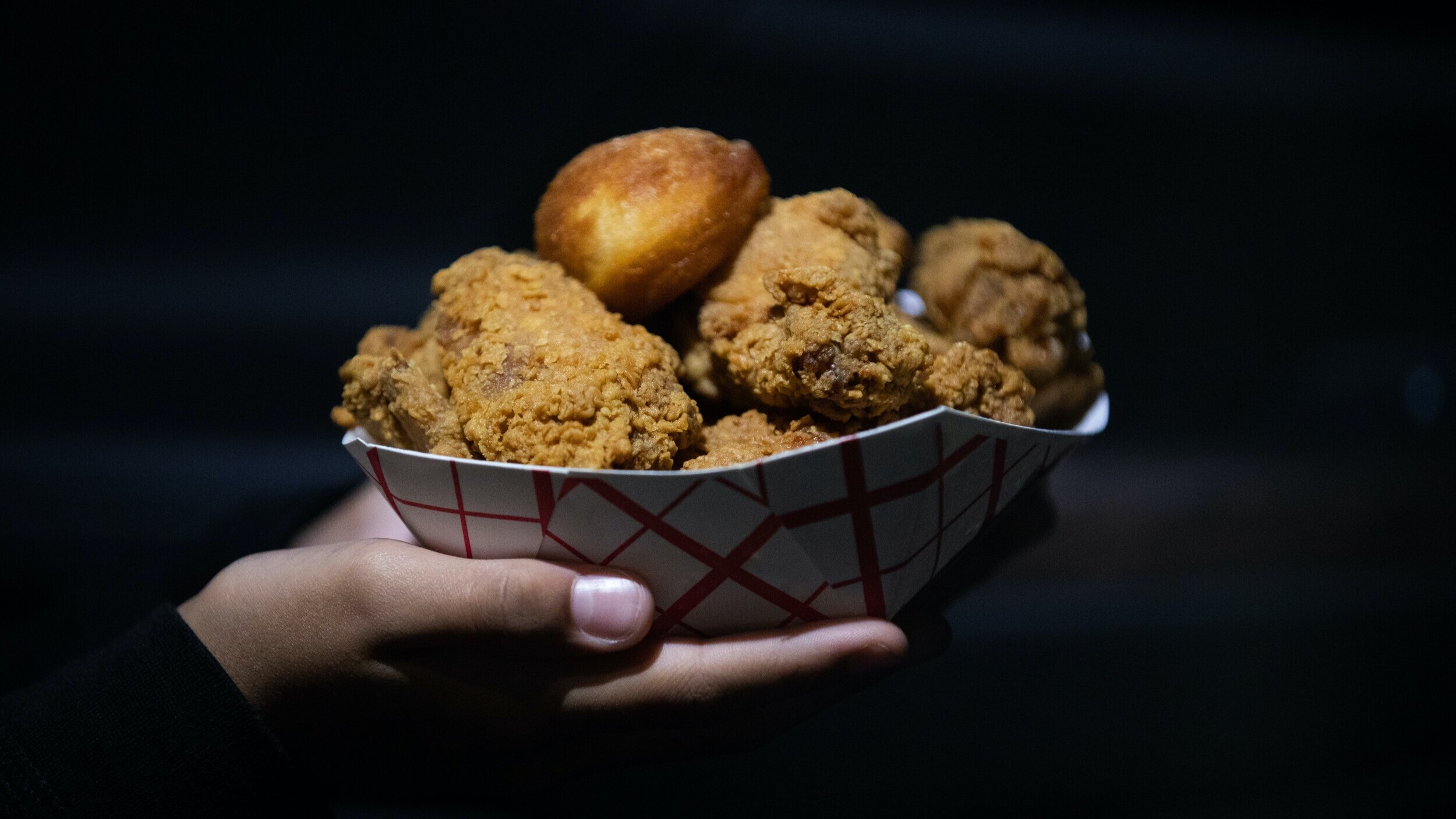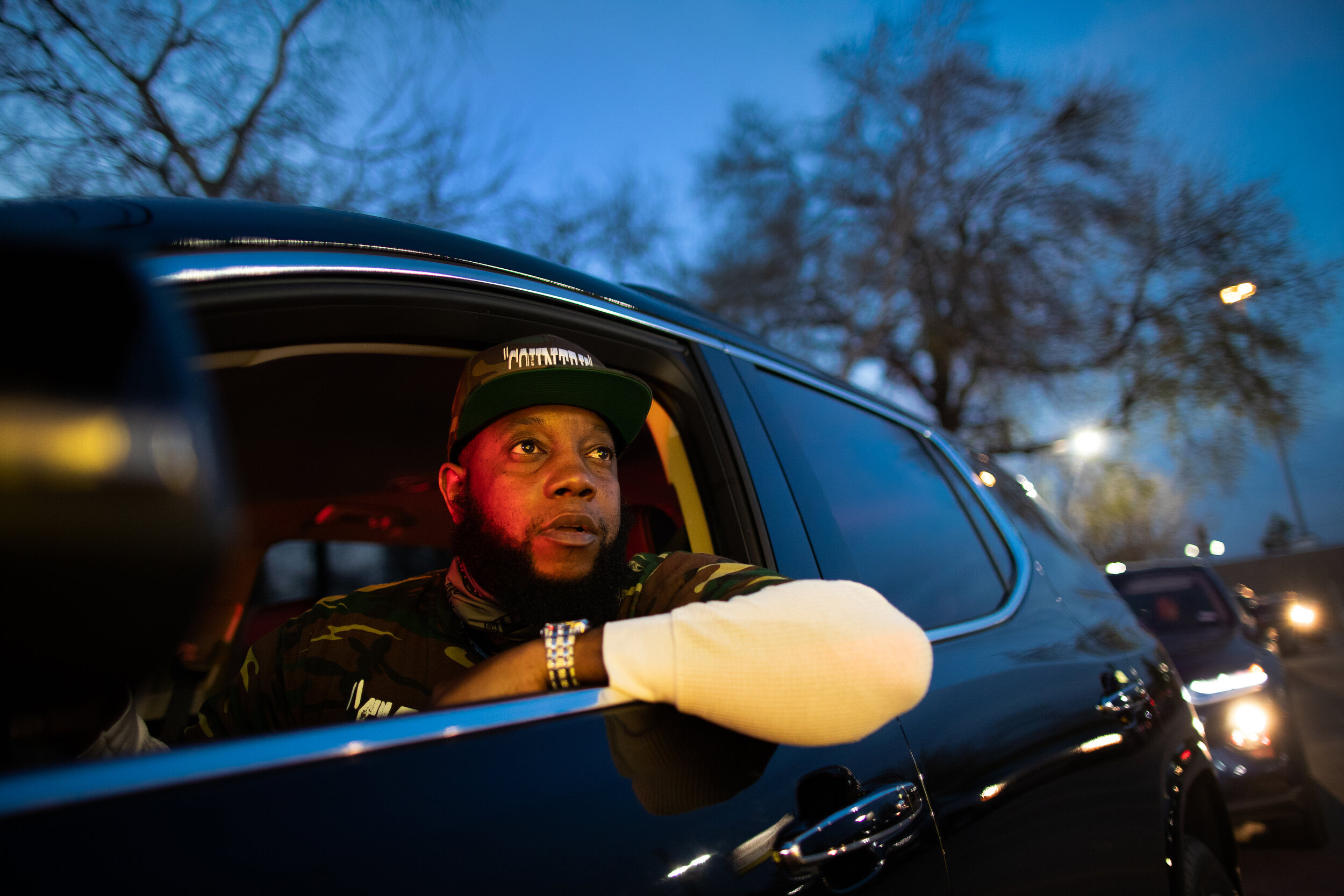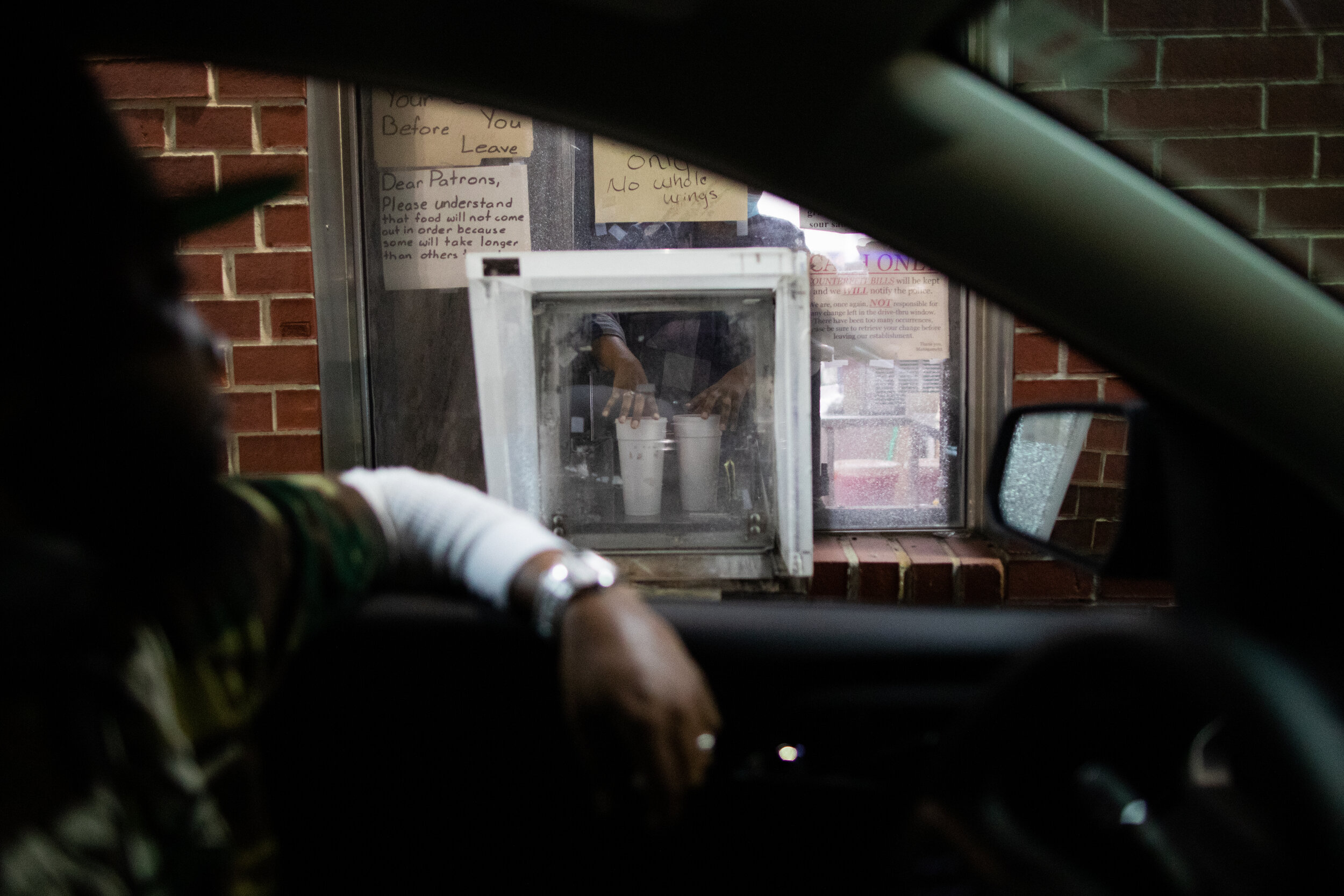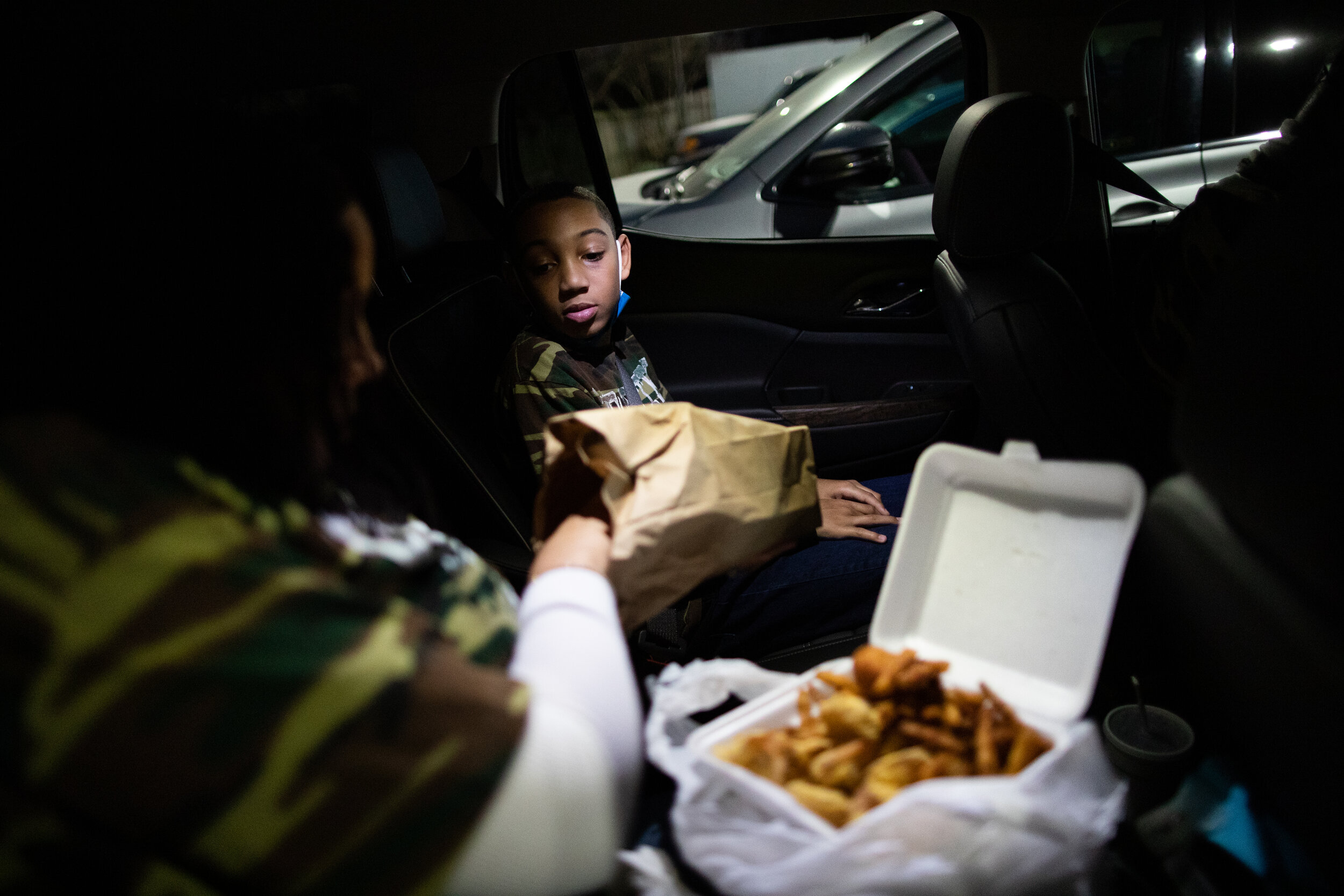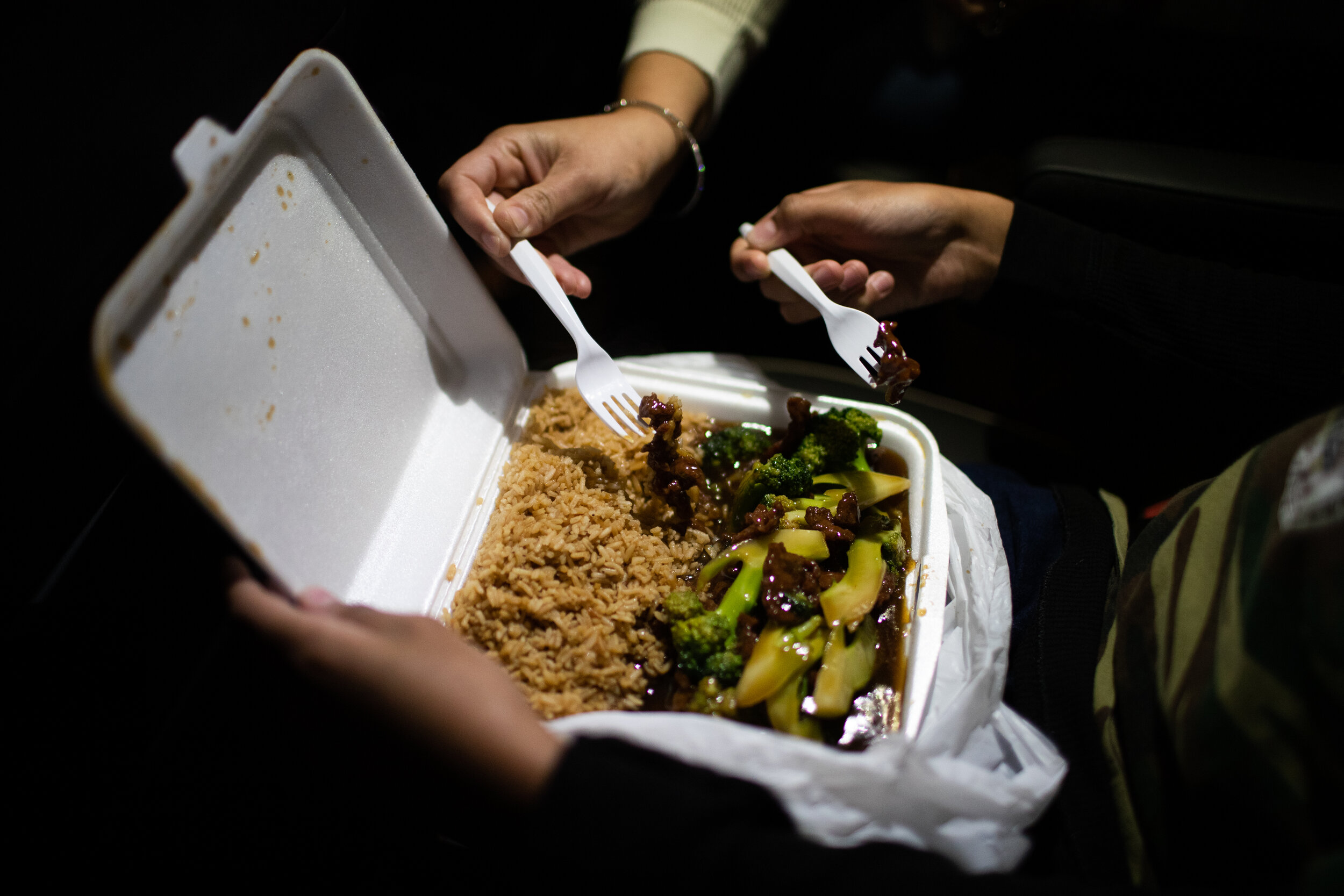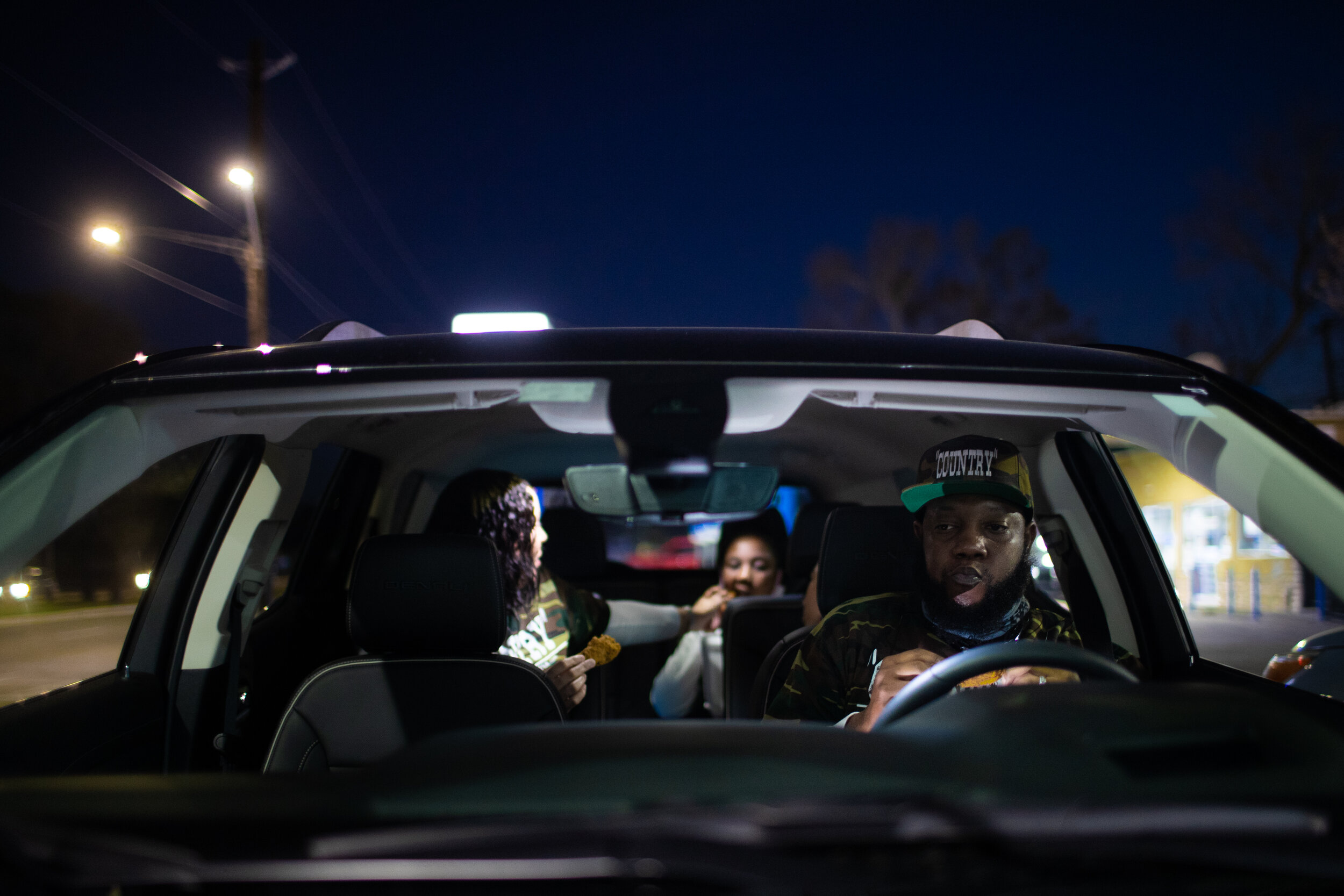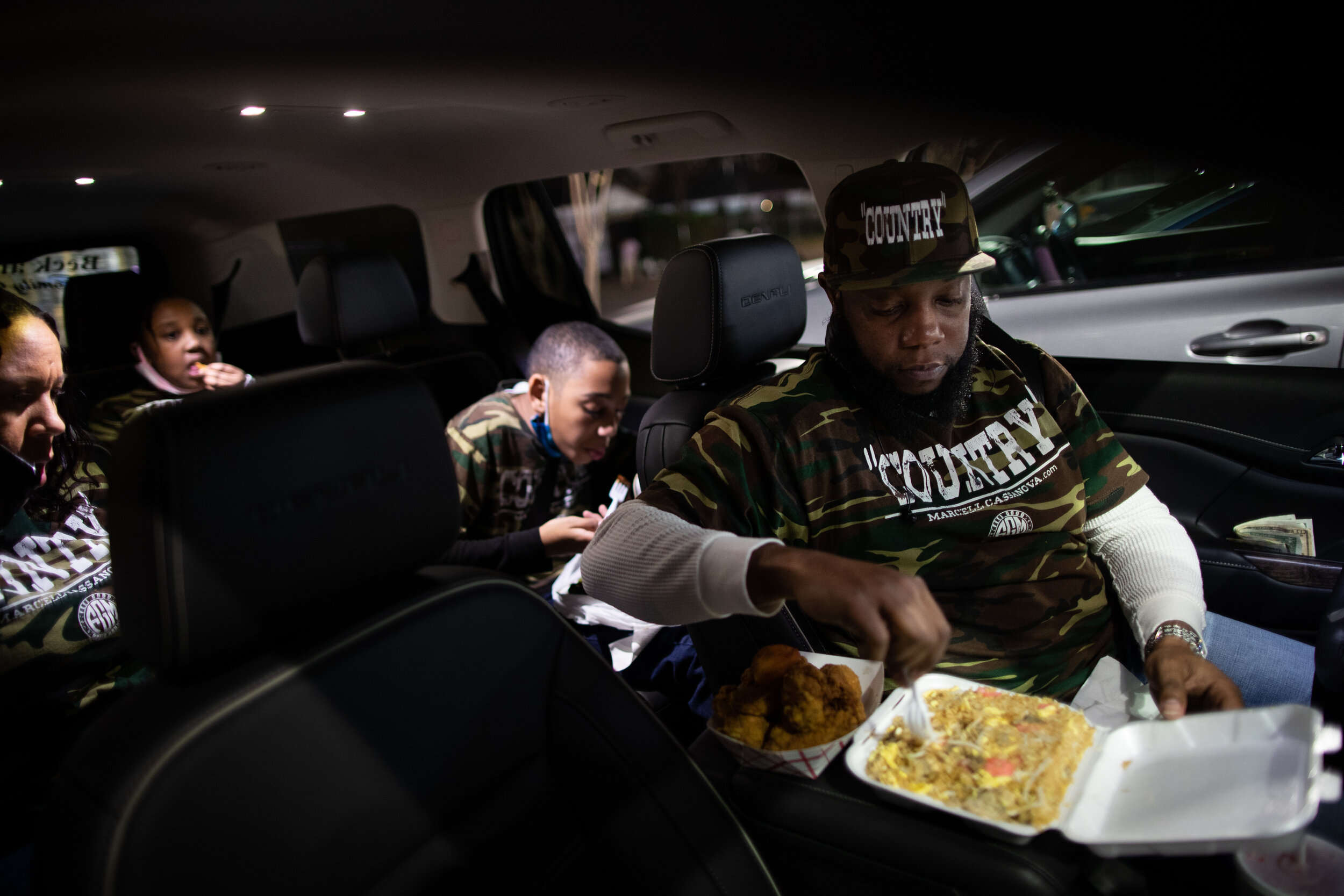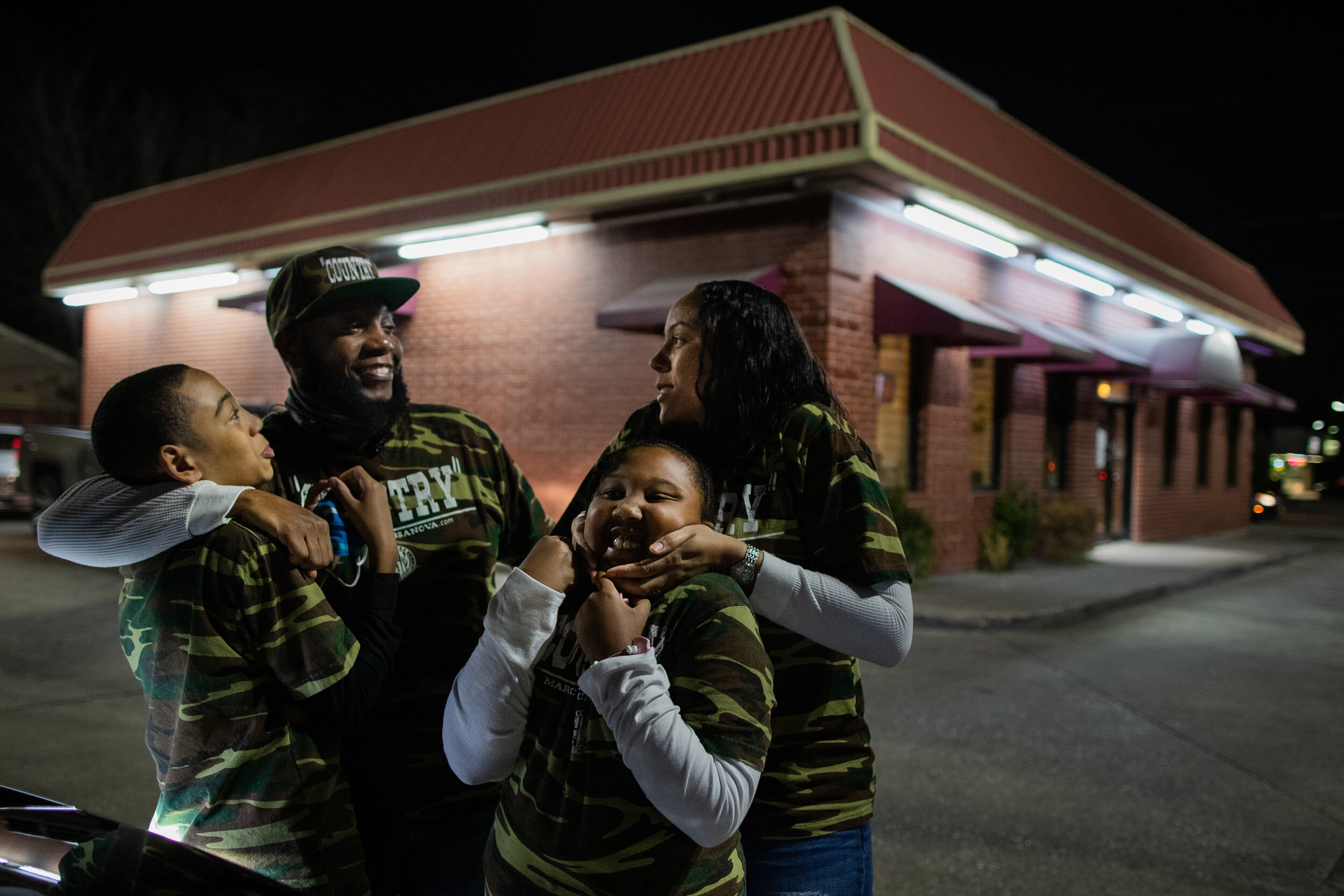Timmy Chan’s fried chicken is legendary in the Houston hip-hop world. Alana Dao delves into the restaurant chain that her grandparents started in the 1950s, and the emergence of chop suey and chopped and screwed.
Story by Alana Dao | Photographs by Marie D. De Jesús
Guest Edited by Charlie Braxton
What you know bout Timmy Chan’s, what you know bout Cloverland
— “Southside,” Big Mello
On my now-husband’s first visit to Houston, my parents took him to see all the “sights.” Sights for us anyway: Chinatown, our favorite dumpling spot, the strip mall where I took ballet lessons. On one car ride, my mother casually mentioned that she had managed a couple restaurants with my grandparents. And after my grandparents had sold their restaurants in the 1980s, the restaurant had become a well-known quick service chain that served fried chicken and rice.
As a child, I’d heard all this before. But this time, she elaborated, telling us that she’d heard a “rap person” talk about my grandparents’ restaurant in one of their songs. That maybe it had been in a music video? My husband’s interest was piqued. All he had to do was a low-key Google search and was shocked to find an Urban Dictionary entry:
Timmy Chans is a chain of restaurant[s] in Houston, tha land of the playas and pimps. The restaurants are a good place to go when you are broke and don't have enough dough. They can be found throughout the great land of Houston and they have become an integral part of the city. The food is not the highest quality but it is the experience of going and getting mountains of rice and chicken at rock bottom prices.
The Original Timmy’s on Martin Luther King Boulevard.
Writer Shea Serrano put Timmy Chan’s famous chicken wing dinner in the Rap Food Reference Hall of Fame. And that “rap person” my mother was referring to was actually Bun B of the group UGK, one of the most well-known rappers from Houston. In the Paul Wall song “They Don’t Know,” we hear the lyrics, “Down here we got ghetto grub / Like Williams Chicken or Timmy Chan’s.”
Timmy Chan’s was a familiar name in our household, but only because it was the restaurant my grandparents started when they moved from the East Coast to the Gulf Coast. Before its entrance into the Hall of Fame, Timmy Chan’s was a restaurant that served Chinese American staples like egg rolls or fried rice and where my mother and her family spent their days.
Like Houston itself, the story of Timmy Chan’s has become larger, intertwining itself with other cultures, urbanization, and hip-hop.
The Cassanovas (Marcell, Yolanda, Ryleigh, and Napolean) live in Humble, Texas, a suburb of Houston. Marcell, a local Southern soul and hip-hop musician, grew up not far from the Timmy Chan’s on Martin Luther King Boulevard, now called Original Timmy’s.
I grew up in Sugar Land, on the outskirts of the city. At the time, there were more grassy fields than houses, and cattle would graze by the railroad off the highway going into Houston. The first time I ever saw a Timmy Chan’s was riding in a car — a 1990 Toyota Camry with my beloved MD Anderson Cancer Center Christmas tape in the cassette deck. I listened to those Christmas carols all year, every year, from age 5 to too long.
I was almost always listening to the sweet voices of children from the cancer center sharing Christmas wishes ringing out in the wet, Houston heat as my mother sped, stopped, pat-patted to stop and start along the highways of Houston. She was always kind enough to push the tape into the deck for me, even on scorching summer days as I sat in the backseat in a sticky sweat, shrinking away from the hot, metal seat belt buckle. One time, she quickly pointed out the window as she drove past a building with a yellow and red awning and said, “That’s a Timmy Chan’s, but not ours.”
Driving by, it looked smaller than I had imagined. In my child-mind, Timmy Chan’s was where my mother had spent her own childhood, and it was the stuff of legends. In these stories, she was a little girl pulling pranks with her brother or a college student quickly rolling egg rolls between classes, surrounded by chefs’ knives flying through bushes of scallions. But as swiftly as she had pointed, Timmy Chan’s flew past my window and we continued, speeding steadily through the city.
While I was probably listening to “We Three Kings of Orient Are” on my Christmas cassette or whatever pop hit 104.1 FM was playing (the morning DJ, Roula of “The Roula & Ryan Show,” had gone to my high school so I felt loyal), the music playing out of cars in the Timmy Chan’s parking lot, so loud the neighborhood around them shook, was primarily chopped and screwed. The historian and author of Hip Hop in Houston: The Origin and the Legacy, Maco Faniel, explains that DJs would slow pitch controls on a song then manipulate the entire thing by “mixing, scratching, and back spinning over it.” The original song evolves into a foggy, unhurried, steady new thing. He tells me that oftentimes, musicians will release an album then drop a subsequent chopped and screwed version to offer more: a stretch in sound, slower lyrics where every word can be heard.
Chopped and screwed may be everywhere now, but in the 1990s, back when Timmy Chan’s was first becoming a part of the hip-hop fold, DJ Screw made copies of his mixtapes and sold them from of his home and at independent music shops — one of which happened to be close to Timmy Chan’s on Martin Luther King Boulevard and Interstate Highway 610.
This serendipitous location gave way to a community hotspot where, as Cedric Hill (better known as E.S.G.), of DJ Screw’s Screwed Up Click, puts it, “The price was good and the food tasted good as well.” He remembers a $2 fried drumstick dinner that came with rice large enough to feed a family. The combination of good, hot food at an affordable price and geographical proximity began to create a place worth mentioning.
Faniel says that Timmy Chan’s is now one of the “most referenced restaurants in Houston music” and that referencing places within a neighborhood is important in the culture of hip-hop. You are rapping and mapping, placing yourself within a larger history. Referencing Timmy Chan’s was a way to tell of where they have been and paint a scene of where they are going, Hill says. He would mention it in his songs “because everybody loved it. If you came from the Southside, everybody would talk about it because it was the place to hang out.”
Dave Anthony, known as DJ Dirty Dave, of Street Pharmacy. For him, Timmy Chan’s always felt “almost like a hub. They didn’t disrespect you there, and it was the perfect place to park the car, blast the music so loud the buildings would shake.”
“Car culture is a part of Houston. Your car is an extension of yourself,” says Dave Anthony, known as DJ Dirty Dave, of Street Pharmacy. He remembers Timmy Chan’s being important for this very reason. With a large parking area to pull up and park, the restaurant lot would fill with “candy slabs, poppin’ trunk, just bangin’ music. It was like a car show.” He tells me that at the end of the week, you could “take your car and go get a girl, go to the Galleria to get some new clothes, then the record shop to buy a tape, then drive over to Timmy Chan’s for wings and noodles and fried biscuits. It was our place.” For him, Timmy Chan’s always felt “almost like a hub. They didn’t disrespect you there, and it was the perfect place to park the car, blast the music so loud the buildings would shake.”
Both Dirty Dave and E.S.G. explained that it became the spot to be because “it was really good.” Different rappers even shot music videos in the parking lot or at other locations. E.S.G. wistfully wishes he had shot his first music video there. It was the place, they said, you took people from out of town to “really experience Houston.”
Out of towner's be comin around
Runnin they mouth be talkin down
But you don't know nuttin 'bout my town
— Paul Wall ft Bun B, “They Don’t Know”
My mother’s parents, Larry and Lily Chu, or to me, Gong Gong and Po Po (the Cantonese terms for maternal grandfather and grandmother), knew a very different Houston. In reading through both of their autobiographies (which they wrote for their Southern Baptist church class) I learned what Timmy Chan’s used to be and of their common struggles.
Born in Canton, China, my gong gong arrived in the United States to reunite with his father in 1937. According to family lore, Gong Gong’s father, my great-grandfather, first came to the United States by way of a barrel on a boat. He arrived in New York where, true to the stereotype, he began a laundromat in Chinatown. The man remained an enigma; my mother recalls gambling in the back and a strong, stolid man. My gong gong must’ve inherited the swagger of his father, this man who floated the seas in a barrel to find his fortune, and to become a man whose funeral turned into a public parade in New York City’s Chinatown.
When Gong Gong Larry arrived in the U.S. for the first time, he was immediately detained in a detention camp in Boston for six months. In his autobiography, he recalls, “I was a young man then, and it was the first time for me to experience discrimination. I resented the way I was being treated.” He “saw no future for me in the United States” so he returned to China but came back in 1946, this time landing in New York where he met my grandmother — where else but working in a restaurant.
In 1949, they married and in a story straight out of a Western, or maybe just a soap opera, my grandfather met “the real estate man from Texas.” Gong Gong and Po Po and a few other friends decided to move to Houston and invest in a restaurant. At the last minute, one of their friends, a professor named Fook Tim “Timmy” Chan, pulled out to return to New York. But my grandparents forged ahead.
Upon arriving in Houston in the 1950s, they opened their first restaurant, naming it after their friend, Timmy Chan. They recall moving to Houston and struggling for years as business was slow. As my grandfather wrote, “With the building of the space center and the development of the oil industries, Houston had became a very active city, hence, our business gradually improved,” and they opened several other locations.
Alana Dao’s maternal grandparents, Larry and Lilly Chu (left), circa 1966 in front of the original Timmy Chan's on the 2300 block of Fannin Street. They moved to Houston from the East Coast and opened Timmy Chan’s in the 1952, naming it after their friend Fook Tim “Timmy” Chan, an educator of Chinese culture and culinary history. Larry Chu, third from the left, with friends in Worcester, Massachusetts, circa 1950 (top right). In 1968 they moved the restaurant to 2606 Fannin St. This photo is from 1970 after they expanded to include banquet halls to host large functions for up to 300 people (bottom right). All photos courtesy of the Chu family.
At the time, Chinese food was considered too foreign and not served regularly. My grandfather created a menu that catered to the local palate, featuring lunchtime specials like New England boiled dinner, chicken and dumplings, and liver and onions. The restaurant became known for its rib-eye steak dinner. But slowly, they began to incorporate American Chinese cuisine into the menu, things we would consider Chop Suey. They began offering chow mein, fried rice, and all those egg rolls my mother folded; foods that Americans liked but had little resemblance to the food they once ate in China.
Before Timmy Chan’s became a part of American Chinese cuisine in Texas, Chan, aka Timmy, had actually been an educator of Chinese culture and culinary history. He once wrote, “the name ‘Chop Suey’ so familiar to the Americans is really unknown to the Chinese. To tell the truth, I have never had any such dish in my life in China.” So while he was an expert of Chinese food and etiquette in its original form, his name carried on to become something else entirely. Chop Suey is Chinese food of American terroir: invented, created, manipulated here in the United States. And like chopped and screwed, Chinese food is a reimagination, a way to adapt to the region where it finds itself, showing up and showing off for the communities it belongs to.
My grandparents had the foresight to expand into downtown Houston next, making their bread and butter on lunch specials and catering to businessmen. As business grew, so did their children. My mother and uncle eventually took over the management of a location each, and soon, my uncle and grandfather decided to open Timmy Chan’s on MLK Boulevard. This location would serve fast-casual food such as fried chicken and rice, the one now so famous in Houston hip-hop.
Beyoncé, one of Houston’s hometown heroes, in her song “Bow Down/I Been On,” honors another Gulf Coast fried chicken chain, Frenchy’s Chicken. Frenchy’s is sometimes mentioned in the same breath as Timmy Chan’s. Frenchy’s, however, was Black-owned, by a man from Louisiana, Percy “Frenchy” Creuzot Jr.
According to my mother and uncle, Creuzot was a customer at Timmy Chan's, and he and my grandfather became good friends. It was Creuzot who passed along a recipe for chicken when my grandfather and uncle decided to open the Timmy Chan’s on MLK Boulevard. As my mother likes to tell it, my gong gong added soy sauce and other spices that made the chicken “more Asian,” but she and my uncle won’t divulge what’s actually in it. As the story goes, Creuzot sampled the Timmy Chan’s version and said it was better than the original Frenchy’s recipe.
Outside businesses coming in and profiting off Black people is not new. And in a way, how an Americanized Chinese restaurant became a cultural icon and touchstone for Houston hip-hop reflects this. An incredibly intricate relationship emerges as cultures and communities bump up against each other and stories build up in a single place.
A place adapts to the palates of the neighborhood and new ways of living and eating are formed. For Timmy Chan’s on MLK, it became, as Dirty Dave recalls, “their spot.” New stories of survival also take root and grow. Family lore stands in to account for what happens to those who were left out of the larger narrative of urban cowboys, outerspace, and “progress.”
My grandfather writes, “In May, 1982, God decided that we should sell our business and to retire.” He leased the Timmy Chan’s on Fannin Street to a Texas-based steakhouse, then sold the quick service locations to families that were already working for them. The MLK location was sold to the Dangs, a Chinese immigrant couple. A Vietnamese immigrant family, the Trans, bought the one on Richmond. The Trans had come to work for my grandparents by way of the Vietnamese refugee diaspora — yet another significant history woven into the city of Houston. From there, Timmy Chan’s became what it is today: an institution in the Houston hip-hop community.
While Timmy Chan’s has been forever immortalized in hip-hop, there is another life in this yellow-and-red restaurant, another history. The history of grand banquet rooms, tableside dinner presentations, and shaking hands with local celebrity regulars like Percy “Frenchy” Creuzot Jr., Marvin Zindler, or the Moody family. Photo courtesy of the Chu family.
Timmy Chan’s, under my grandparents’ ownership, had been the quintessential high-end Chinese restaurant for (primarily) white, middle-class patrons. One replete with large banquet halls decked out with cloth napkins, red and gold decor, and dishes like shrimp with lobster sauce and egg foo young. Photos show my grandparents schmoozing with smiling regulars in front of a dazzling bar and shiny black and gold menus — a space with its own narrative.
While Timmy Chan’s has been forever immortalized in hip-hop, there is another life in this yellow-and-red restaurant, another history. The history of grand banquet rooms, tableside dinner presentations, and shaking hands with local celebrity regulars like Creuzot, Marvin Zindler, or the Moody family, has all but disappeared and been replaced with counter service and menu boards.
What remains still leaves a taste of what my grandparents first started: a place to show up and show off, a place to be at ease. Dirty Dave remembers Timmy Chan’s was the place to go because it “was our place for African American youth, where they didn’t disrespect … people in the urban community felt welcome and they treated you with respect.”
I think of my grandparents’ tenacity: my gong gong’s swagger, my po po’s desire for grandeur and economic comfort, and the struggle against poverty and discrimination. I think it was with this same spirit that they started Timmy Chan’s. What they first created has become a place of comfort for some, even if not in the way my grandparents had expected. It is also a place that rebels, adjusts, and adapts to change in its own way.
Houston hip-hop takes this concept further. Chopped and screwed, leaning into a slower sound is a resistance against the harsh backdrop of capitalism and being stuck in traffic on Interstate 10. A way to connect and cope against larger systems. Hip-hop in Houston tells of a specific time and place, of lives lived in the face of hardship. In spite of natural and constructed forces whether it be hurricane season, racism, or even the criminalization of simply being, the music declares: we are still here, still seen.
It is in the spirit of the Gulf Coast — the Third Coast as Bun B says — and Houston that, as things are destroyed around us, we build and rebuild. We, of the Gulf Coast, have grit, determination, and hustle. Dirty Dave, E.S.G., and Bun B are just several rappers from the Houston area that never forgot their roots, referencing and connecting others to their sense of place and, quite literally, putting it on the map.
And like them, my gong gong and po po had the determination to build and build and build. As Michael P. Jeffries writes about Southern rap, “The South is no longer the aggrieved underdog; it is king of the hill. Its climb was a beautiful and disjointed process, as piece by piece, cities and rappers with their own ideals of Southern authenticity scraped and clawed their way upward.”
I never really experienced Houston hip-hop or the family business, but something of that grit and grease followed me. I left for New England after high school with the only one piece of advice my mother often repeated to me: Never work in a restaurant.
But, as I finished college in the face of the Great Recession, a restaurant was the only place I found work. Even after grad school it was hard to find work. I landed in, of all places, a Southern-inspired restaurant in Maine known for its fried chicken. I was attracted to the energy that can only be found working in restaurants.
Not only did the anticipation of service, the beat of the kitchen, the rhythm and pace of a dinner rush as customers clanked away get me going, but I realized I was good at the work.
I believed fried chicken would define my existence. Food, fried chicken, and hot platters were in my blood, my family’s blood, and no matter how hard we tried, this was my fate. Miles from home, I was destined to always be around the smell and sizzle of grease popping and food cooking.
Everything has a weird and winding road to get to where it’s going, be it chicken, music, or who we are. So now, rather than thinking of restaurant work as some predetermined fate, I think of food as a way to place ourselves in history. A history ever-changing and evolving, uncovered and revealed as buildings shake around us. I, too, can stretch a sound or explore a beat, resist by my own presence, at a pace where my words can also be heard. And I realize: it’s not the chicken that is my destiny, it’s the hustle.
Alana Dao is a mother, writer, and restaurant professional. Her writing often explores race, contemporary culture, and food. Her previous writing has been featured in The Kitchn, VICE, and the Huffington Post, among other publications.
Marie D. De Jesús is a staff photojournalist at the Houston Chronicle. Born and raised in Arecibo, Puerto Rico, life took her to Florida 16 years ago. An elective photography class in college gave her the idea of making photography a career. She spent three years at Gannett’s Democrat & Chronicle in Tallahassee before moving to Houston.
Charlie Braxton is a poet, playwright, and music journalist/historian based in Jackson, Mississippi. His work has appeared in magazines around the world, including Vibe, The Source, and XXL.

